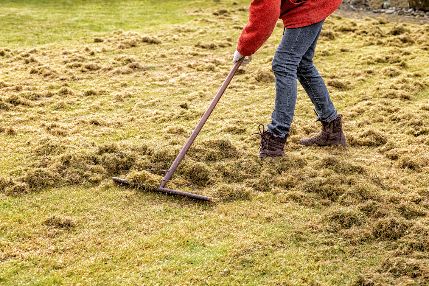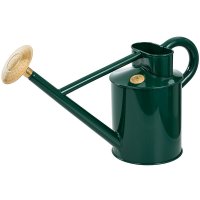
A beautiful lawn is the first impression people get of any garden. However, gardeners know that a beautiful lawn does not take care of itself, but requires a lot of work. In spring and summer in particular, gardeners have to get to work in order to care for and maintain the lush green of their lawn.
Lawn Scarification: Why, When and How Often?
Over the year, a lot of organic matter accumulates on the lawn: decaying leaves, cut grass or weeds. These materials decompose poorly or very slowly on the green surface and a thick thatch layer of moss and weeds quickly forms on the lawn. Water can no longer penetrate the soil so well and the lawn becomes very susceptible to drought.
For this reason, scarification should be carried out at least once a year, so that the grass can breathe again and grow back thickly. Lawn scarification takes place in spring. What happens when scarifying the lawn? The scarifier cuts through the surface to loosen moss and thatch deposits from the soil and remove them from the lawn.
How to Scarify the Lawn Step by Step?
- Cut through the entire lawn area with a lawn scarifier. The scarifier has sharp blades instead of prongs like a conventional garden rake.
- The loosened material, the thatch, is then removed. You can easily collect it with a garden rake, a leaf rake or a leaf claw. A useful insider tip: Use a lawnmower to collect the coarse thatch waste in its catcher compartment.

- After scarifying the lawn, overseed to fill any gaps in the lawn. To promote new grass growth, apply a lawn fertiliser.
- When the new grass is about seven centimetres high, it is time to mow.
Do not be afraid of scarifying the lawn – it may look wild, uneven and patchy afterwards, but it will grow back more beautiful and healthier a few weeks later. Scarifying is an important lawn care process. Gardeners need not be afraid of destroying the turf with it.
How to Properly Use the Lawn Aerator?
Lawn aerators and scarifiers are often lumped together, but they are quite different garden care tools. The lawn aerator, whose long spikes prevent unwanted moss from forming in the lawn in the first place, is pulled out of the garden shed several times a year. Gardeners can quite easily aerate their home lawn four to five times per mowing season and thus contribute to optimal maintenance.
A lawn aerator loosens the heavily compacted soil so that the air and nutrients reach the roots and the turf. Surface thatch and moss are thus eliminated in the early stages.
If puddles occur after heavy rain, this is an unmistakable sign that you have to use the lawn aerator. This is exactly where the soil is already too compacted – the roots are no longer being supplied with enough nutrients and moss grows. By the way, after aerating the lawn is also a good time to fertilise the grass.

The Perfect Watering of your Lawn in Summer
As soon as it gets really hot for three days in a row, the first brown spots start to form on an otherwise so uniform lawn. Watering is a topic that no gardener can avoid. Grasses do not root very deep – only about 15 centimetres. This means that in hot summers their roots do not penetrate into deeper layers of soil where the earth is still moist. This is also the reason why the lawn is the first thing to become dry if the area is not regularly watered and the drought is severe.
Watering is best done in the early morning hours, so as to reduce water evaporation due to strong sunlight. The applied water must have the chance to penetrate to the grass roots and not immediately evaporate from the surface. The easiest way for the gardener is to use automatic watering, whereby a stable sprinkler base including spray nozzle is placed in the middle of the lawn and activated by means of a timer. The water hose can be laid across the garden in a very retro style with a hose guide spike.
But the lawn can also be watered using a watering can. Just make sure that the lawn is regularly watered to provide the soil with sufficient moisture.

How Much and How Often to Water Your Lawn?
As with all plants in the garden, the same applies to the lawn: it is better to water less frequently, but more intensively. Experts recommend using around 20 litres per square metre once a week. Since the turf cannot retain water so well, the sprinkler is also used more frequently in hot weather.
To check how well the roots are still being supplied with water, just stick a finger into the soil. If the soil is dry and dusty only a few centimetres down, dryness prevails on the lawn. By the way, turf is even more susceptible to drought. Gardeners must follow the manufacturer's recommendations so that the turf grows well in their own garden.









